Ways and methods of dealing with a bear in the garden: how to process, what means and preparations
Experienced summer residents are well aware that there is no evil spirits worse than a bear on the site. Mole cricket (also called earthen cancer, spinning top, cabbage, bear) is the most common, the most hardy, the most elusive insect - a pest. Everything is explained very simply. Any kind of soil is a home for him. In addition, the gluttonous insect does not disdain anything and eats up everything in its path: roots, and stems, and young shoots, as well as earthworms and May beetle larvae. Nature has provided him with all kinds of devices for movement everywhere: in the ground, in the air, in the water. And yet there are ways to get rid of a powerful enemy.
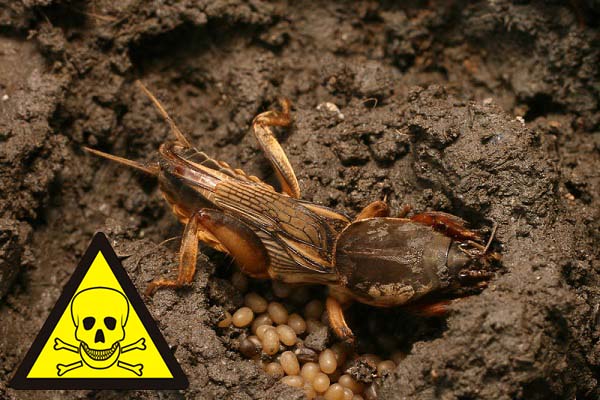
Content
Who is a bear and how is she dangerous?.
In the garden, the bear prefers the most humid and well-heated places, as well as those with humus and manure.
She especially attacks cabbage, onions, potatoes, tomatoes, carrots, beets, eggplants, cucumbers. In her gut and flower bulbs, roots of shrubs and trees.
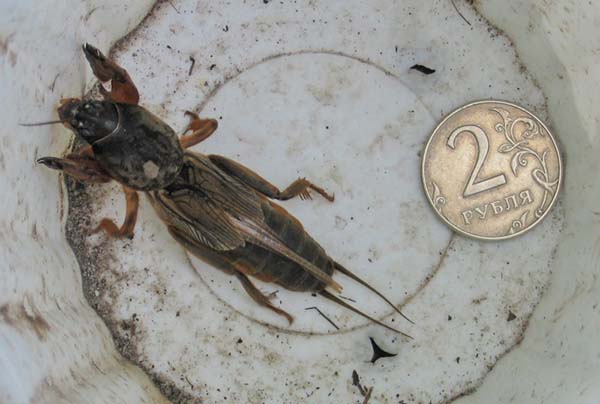
Earth crayfish with great pleasure settle in our plots and in search of food for procreation, moving in the upper layers of the soil, gnaws at the root system of the plant and spoil the leaves. If yesterday you planted seedlings, and they stood perfectly, then in the morning, if there are bears in your garden, the seedlings may fall and completely wither.
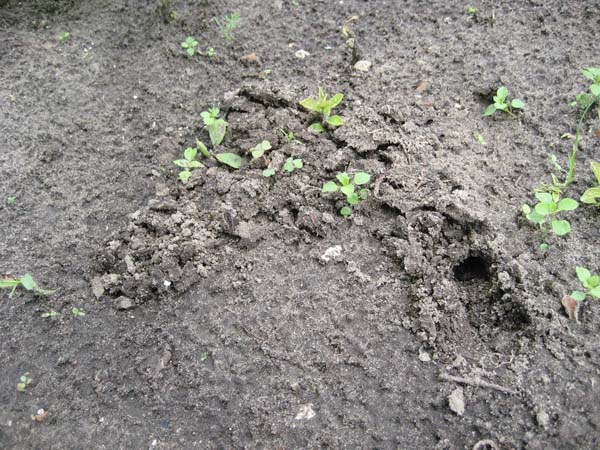
Signs of appearance cabbage in the garden are small loosened holes in the ground. As soon as you find them, you need to immediately take measures to combat the bear.
Video: what a bear looks like and how to deal with it in the garden
Chemicals to combat the bear
The most famous and popular drugs for the destruction of a bear are:
- Anti-Medvedka;
- Boverin;
- Grizzly;
- Thunder;
- Medvetox;
- Medvecid;
- Zarin;
- Rofatox cuts;
- Frontier;
- Rembeck;
- Regent;
- Phenaxine plus.
It is necessary to apply funds strictly in accordance with the instructions attached to the preparations.
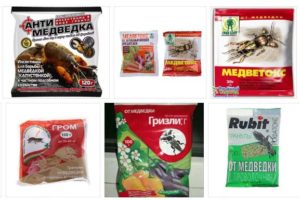
By the way! In addition to cabbage, some preparations are excellent at fighting other garden pests, for example, wireworms, beetle larvae and giant garden ants.
Folk remedies against the bear
The main advantage of using folk remedies to get rid of a bear is that you do not use chemistry, although certain methods still include the use of chemicals in combination with folk tricks. However, it should be understood that some of the methods and means are not capable of destroying all the cabbage in the garden, but in combination and in the complex they will be very effective.
Advice! Please note that the proposed remedies help to fight the bear at different stages of its appearance. For example, you can pre-protect the garden from the invasion of pests (even in the fall or early spring), or just the time of planting seedlings, or work "in fact" the appearance of cabbage in the garden.
Vegetable bait
Use a large enough carrot or beet. In order for an alluring smell to emanate from the root crop, slightly break or damage its shell. Dig a hole along the length of the entire carrot, put the root vegetable there and cover it with earth. Then spread the poisoned baits around the carrots and slightly dip them. To spread the odor even more, water the place where the bait is embedded.
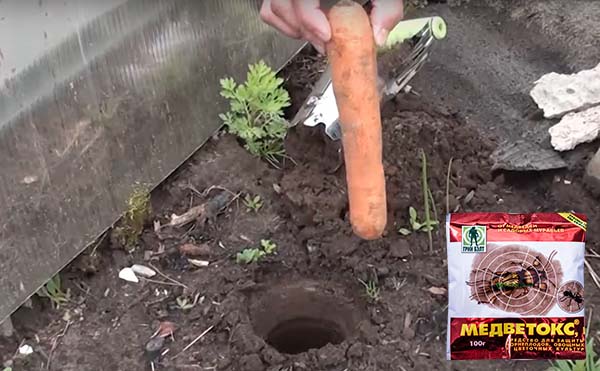
Dung bait
When you dig up the beds in the fall, put a few dung heaps in the garden (and it is best to take horse manure). It can also be done in early spring. When, with the onset of warmth, the bear wakes up and begins to lay eggs, then most likely she will choose one of these dung heaps. You just have to burn it in a timely manner.
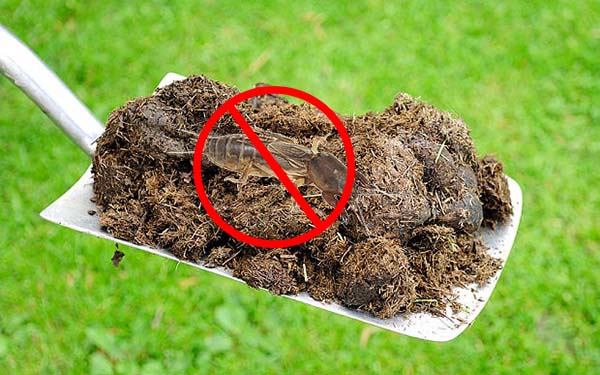
Boiled porridge bait
Boil pearl barley, oatmeal or buckwheat porridge, add fragrant unrefined oil to it for an attractive smell in a proportion of 1 tbsp. a spoonful of vegetable oil in a 0.5 liter jar of porridge. And then put one of the chemical sending drugs against the bear into the porridge and spread it in the cabbage paths.
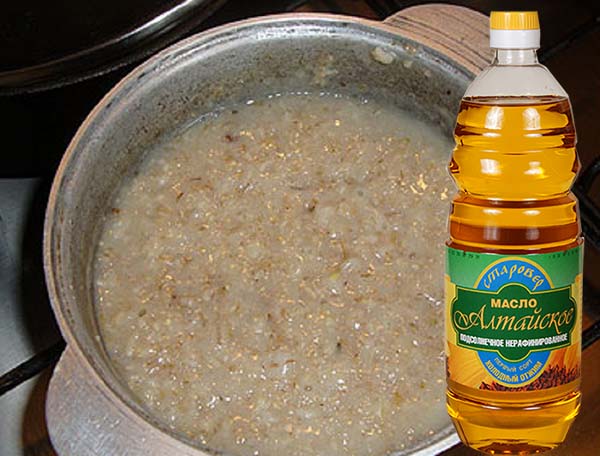
Traps with beer, honey or yeast with sugar
Take a bottle or jar and lightly fill it with beer, water with yeast and sugar, or brush with honey. Dig a hole not far from the typical habitats of the bear, put a container there and dig in with earth. Cover the top with a sheet of cardboard, gauze or a bucket lid (depending on the container used). When the cabbage comes to an attractive smell for her, it will fall into a trap and will no longer be able to get out.
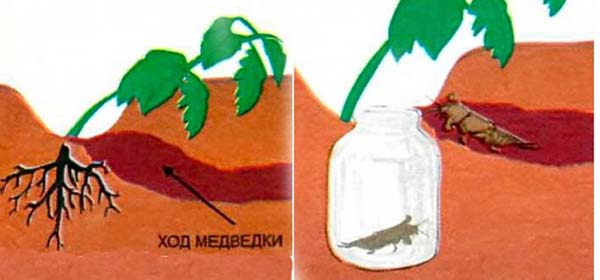
Important! For more information on making each of the traps, see the videos below.
Video: a trap for cabbage with honey
Video: trap for cabbage with beer
Video: trap for cabbage with yeast and sugar
Note! This method is unlikely to cope with a large invasion of the bear, but it will do quite well for solving issues with small pests. Moreover, it is very entertaining.
Roofing material lures
Put the old pieces of roofing material directly on the noticed cabbage passages, and then press them on top with pebbles and leave. The fact is that the bear most of all loves to make nests where the earth is moist and well warmed up, namely, under the black roofing material, the necessary conditions are created. When the time comes, put on gloves and lift up the roofing felt sharply. Most likely, you will find a whole nest of cabbage cabbage that you will need to destroy with your hands or other objects.
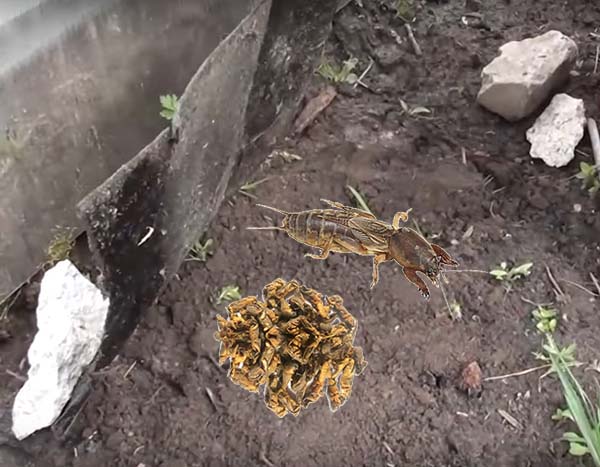
Egg shell treatment
Start collecting in advance eggshell... As soon as there is a sufficient amount, crush it well so that it is of a medium fraction (5 by 5 mm), but in no case free-flowing, like sand (flour). When the crushed shell is ready, pour it over with unrefined oil for a more attractive smell (although many use it without oil). Even before planting the seedlings, while digging the beds or creating grooves, sprinkle it all eggshell... When the bear shows up and begins to feast on her, she will not be able to digest it.
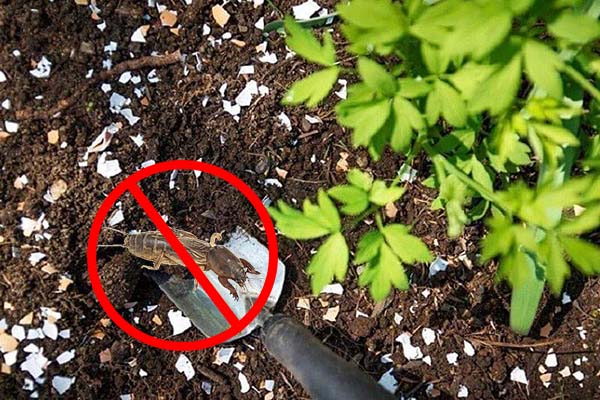
A solution of detergent and dishwashing detergent
At the bottom of the bucket, you need to pour a little washing powder (a couple of handfuls) and pour a little (about 2-3 tablespoons) of any dishwashing liquid. Then add some water, dissolve well until a good soapy solution is obtained. After that, fill the bucket to the top and water the bear burrows in the garden.
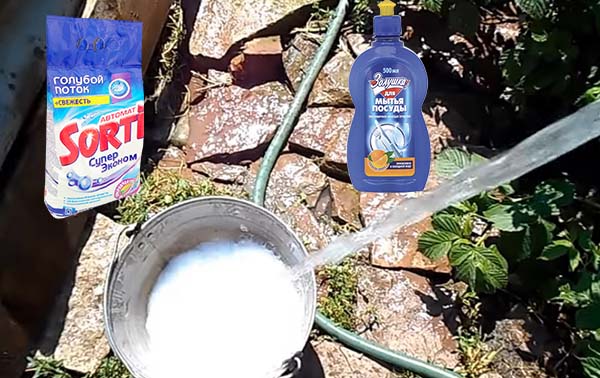
Important! The method is rather controversial (because the powder contains phosphates, synthetic flavors and other additives that are not very useful for the soil), but effective.
Video: how to get rid of bears using washing powder and dishwashing liquid
Soap solution
Take 100 grams of laundry or tar soap and grate. Then dissolve in a bucket of water and pour the bear's minks. For those cabbage that will crawl to the surface, beat it with a shovel or some other object (for example, a fork). All other insects must die in their poisoned holes.
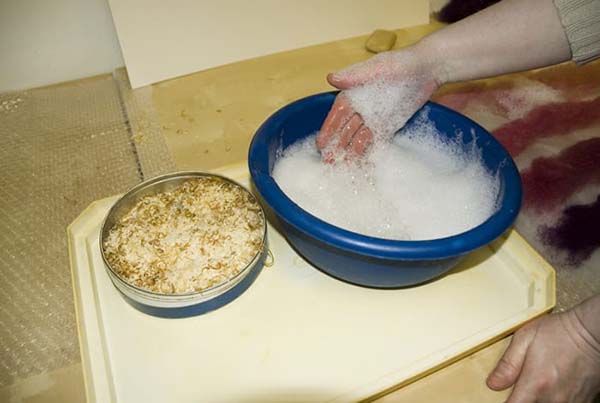
Note! The method is very similar to the previous one, but soap solution is safer than detergent.
Birch tar solution
Take sawdust and birch tar (very effective and environmentally friendly). In order for the sawdust not to acidify the soil, they must first be poured with boiling water, and then add tar (2-3 tablespoons of the product per 1 liter of water) and mix well. When you plant the seedlings, put sawdust soaked in tar at a depth of 2 centimeters next to the seedlings, and then sprinkle with earth. When the smell disappears, the seedlings will become strong enough, and the bear will no longer be able to do significant harm to it.
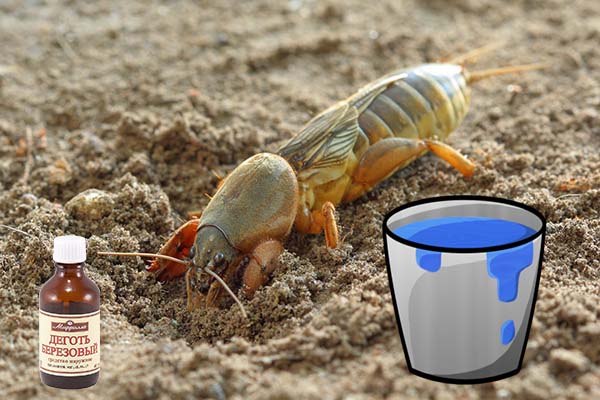
Video: a super way to protect seedlings from a bear using birch tar
A solution of ammonia (ammonia)
A solution of ammonia (ammonia) is not only an excellent feeding, but also an effective method in the fight against a bear. You need to dilute the product as follows: take 10% ammonia and add 1 tbsp to 10 liters of water. spoon, stirring well. Water the newly planted seedlings under the root with the solution, try not to get on the leaves. After the water is absorbed, mulch with loose and dry soil so that ammonia does not evaporate for a long time, but acts in the soil.
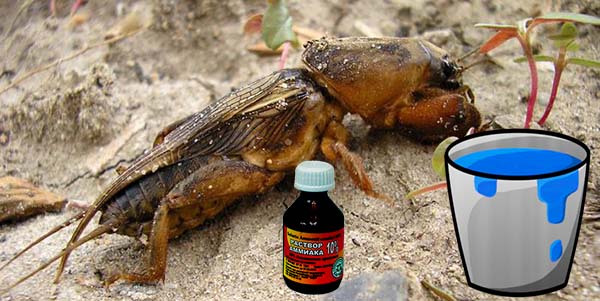
Video: ammonia from a bear
Plant repellents
Cabbage can not stand the smell of certain plants: flowers, trees, vegetables and greenery.
To protect against the bear, you can plant the following flowers around the beds: marigold, chrysanthemums and calendula.
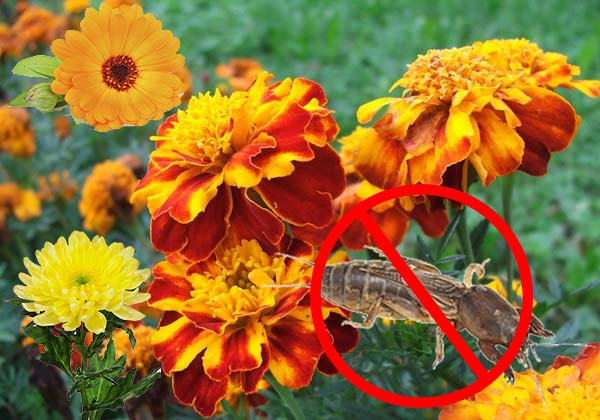
Conifers (sprigs of fir, pine or spruce), which should be placed along the beds, are excellent against cabbage.
You can also stick fresh alder or aspen branches into the soil. The branches should be 2-4 centimeters in diameter, and the embedment depth should be about 20-30 centimeters.
By the way! The bear has natural enemies: crows, starlings, hoopoes, shrews, lizards, molesand hedgehogs. Perhaps crows still do not need to be attracted to your site, but starlings and hedgehogs are quite acceptable.
Video: folk methods of dealing with a bear
Direct (direct) protection of seedlings from a bear
You can also prevent the kapustyanka from killing and damaging the seedlings by directly protecting the seedlings themselves from attack.
For example, you canwrap seedling roots in cloth or cotton wool.
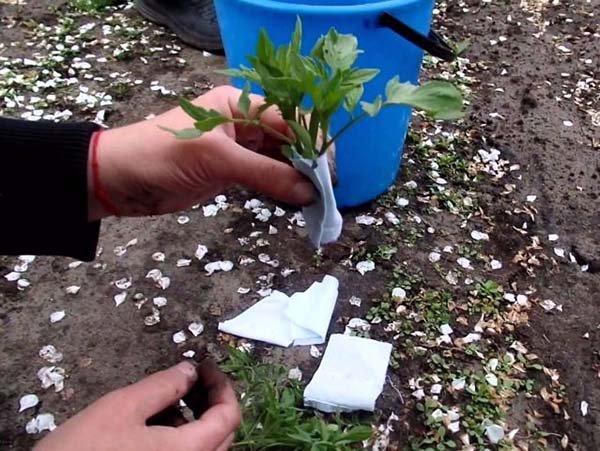
Video: an easy way to protect seedlings from a bear
Another option is put a cut plastic bottle on the seedlings.
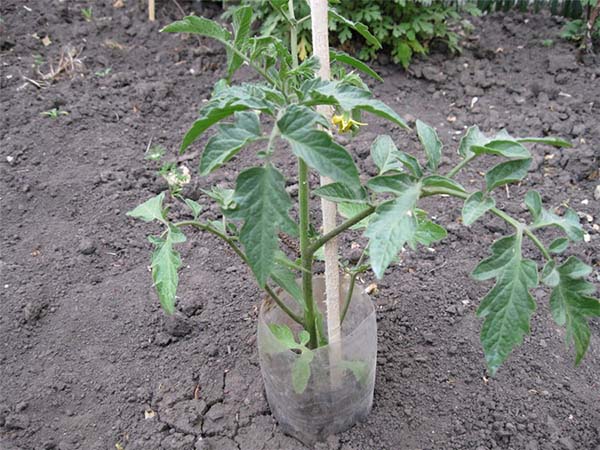
There is not a single gardener who would not be grieved by the bear. However, there are still proven methods of struggle that will help overcome this sophisticated enemy of summer cottages.
Video: how to get rid of a bear - medvetox and other ways

